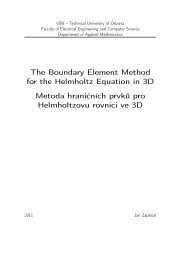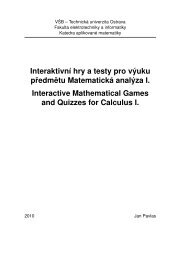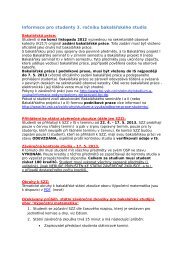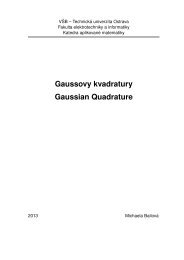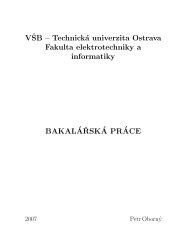Lyapunov exponents of the predator prey model Ljapunovovy ...
Lyapunov exponents of the predator prey model Ljapunovovy ...
Lyapunov exponents of the predator prey model Ljapunovovy ...
Create successful ePaper yourself
Turn your PDF publications into a flip-book with our unique Google optimized e-Paper software.
5<strong>the</strong>re is an uncountably infinite set that is scrambled under that map. Roughly speaking itmeans that every pair <strong>of</strong> points in this set come infinitely close under some iteration <strong>of</strong> <strong>the</strong>map without staying close. T. Y. Li and J. A. Yorke proved that period three implies chaosfor continuous self maps on <strong>the</strong> interval. This result was improved by J. Smítal in [32]where it is shown that a two point scrambled set yields uncountable one for continuousmaps on <strong>the</strong> interval. The Sharkovskiĭ’s <strong>the</strong>orem says that if <strong>the</strong> continuous map oninterval has periodic point <strong>of</strong> period three <strong>the</strong>n it has periodic points <strong>of</strong> all periods, socalledSharkovskiĭ’s ordering was built (see [15, page 44]). Let us point out that it is notpossible to generalize Sharkovskiĭ’s <strong>the</strong>orem for general maps or spaces. It suffices totake rational rotation on <strong>the</strong> circle as counterexample.With o<strong>the</strong>r definition <strong>of</strong> chaos came later R. L. Devaney [8] in 1989. The map is chaoticin <strong>the</strong> sense <strong>of</strong> Devaney if it has dense set <strong>of</strong> periodic points, it is transitive and sensitiveon initial conditions. This definition became famous for <strong>the</strong> third assumption, <strong>the</strong>sensitive dependence on initial conditions. But later it was proved [4] that sensitive dependenceon initial conditions is superfluous.In [33] authors shew that <strong>the</strong> chaos in sense <strong>of</strong> Li-Yorke or Devaney is not stable. Thereexist functions that exhibit chaotic behavior but lose it under arbitrary small perturbations.The stronger version <strong>of</strong> Li-Yorke chaos, called <strong>the</strong> distributional chaos, was introduced[32]. The distributional chaos is defined by sequence <strong>of</strong> distribution functions<strong>of</strong> distances between <strong>the</strong> orbits <strong>of</strong> two points. The system is said to be deistributionallychaotic if <strong>the</strong>re exists a pair <strong>of</strong> points for which <strong>the</strong> limes inferior <strong>of</strong> such sequence is notequal to its limes superior.There exist o<strong>the</strong>r definitions <strong>of</strong> chaos, in [21] on ω-chaos, in [36] on Devaney’s chaos,in [16] on Block-Coppel’s chaos, in [28] on Robinson’s chaos, in [12] on Kato’s chaos andin [3], [13] on mixing properties.. Relationships between different kinds <strong>of</strong> chaos werestudied by many authors but <strong>the</strong>re are still unsolved implications [14], [20]. That is whywe can not determine which definition is <strong>the</strong> strongest.Now when <strong>the</strong> chaotic behavior is defined we want to indicate such behavior andquantify it. The question is how to detect if <strong>the</strong> system is chaotic. And if it is that case,“how much” is <strong>the</strong> system chaotic? In this <strong>the</strong>sis we focus on one technique which is usedfor indication <strong>of</strong> chaotic behavior and which can quantify it, <strong>the</strong> <strong>Lyapunov</strong> exponent isexplored.Organization <strong>of</strong> <strong>the</strong> <strong>the</strong>sisIn <strong>the</strong> next section, Preliminaries, <strong>the</strong> basic definitions and <strong>the</strong>orems are set, which areused in later parts. The most important part <strong>of</strong> this section is <strong>the</strong> Birkh<strong>of</strong>f Ergodic Theorem(Theorem 2.22) which is very useful tool for computing <strong>the</strong> <strong>Lyapunov</strong> <strong>exponents</strong>.



